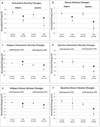Longitudinal Changes in Volumetric Breast Density with Tamoxifen and Aromatase Inhibitors
- PMID: 28148596
- PMCID: PMC5457346
- DOI: 10.1158/1055-9965.EPI-16-0882
Longitudinal Changes in Volumetric Breast Density with Tamoxifen and Aromatase Inhibitors
Abstract
Background: Reductions in breast density with tamoxifen and aromatase inhibitors may be an intermediate marker of treatment response. We compare changes in volumetric breast density among breast cancer cases using tamoxifen or aromatase inhibitors (AI) to untreated women without breast cancer.Methods: Breast cancer cases with a digital mammogram prior to diagnosis and after initiation of tamoxifen (n = 366) or AI (n = 403) and a sample of controls (n = 2170) were identified from the Mayo Clinic Mammography Practice and San Francisco Mammography Registry. Volumetric percent density (VPD) and dense breast volume (DV) were measured using Volpara (Matakina Technology) and Quantra (Hologic) software. Linear regression estimated the effect of treatment on annualized changes in density.Results: Premenopausal women using tamoxifen experienced annualized declines in VPD of 1.17% to 1.70% compared with 0.30% to 0.56% for controls and declines in DV of 7.43 to 15.13 cm3 compared with 0.28 to 0.63 cm3 in controls, for Volpara and Quantra, respectively. The greatest reductions were observed among women with ≥10% baseline density. Postmenopausal AI users had greater declines in VPD than controls (Volpara P = 0.02; Quantra P = 0.03), and reductions were greatest among women with ≥10% baseline density. Declines in VPD among postmenopausal women using tamoxifen were only statistically greater than controls when measured with Quantra.Conclusions: Automated software can detect volumetric breast density changes among women on tamoxifen and AI.Impact: If declines in volumetric density predict breast cancer outcomes, these measures may be used as interim prognostic indicators. Cancer Epidemiol Biomarkers Prev; 26(6); 930-7. ©2017 AACR.
©2017 American Association for Cancer Research.
Figures


Similar articles
-
Longitudinal Changes in Volumetric Breast Density in Healthy Women across the Menopausal Transition.Cancer Epidemiol Biomarkers Prev. 2019 Aug;28(8):1324-1330. doi: 10.1158/1055-9965.EPI-18-1375. Epub 2019 Jun 11. Cancer Epidemiol Biomarkers Prev. 2019. PMID: 31186265 Free PMC article.
-
Comparison of Clinical and Automated Breast Density Measurements: Implications for Risk Prediction and Supplemental Screening.Radiology. 2016 Jun;279(3):710-9. doi: 10.1148/radiol.2015151261. Epub 2015 Dec 22. Radiology. 2016. PMID: 26694052 Free PMC article.
-
Automated Volumetric Mammographic Breast Density Measurements May Underestimate Percent Breast Density for High-density Breasts.Acad Radiol. 2017 Dec;24(12):1561-1569. doi: 10.1016/j.acra.2017.06.002. Epub 2017 Jul 25. Acad Radiol. 2017. PMID: 28754209
-
Reducing the risk for breast cancer recurrence after completion of tamoxifen treatment in postmenopausal women.Clin Ther. 2007 Aug;29(8):1535-47. doi: 10.1016/j.clinthera.2007.08.013. Clin Ther. 2007. PMID: 17919537 Review.
-
Obesity and endocrine therapy: host factors and breast cancer outcome.Breast. 2013 Aug;22 Suppl 2:S44-7. doi: 10.1016/j.breast.2013.07.008. Breast. 2013. PMID: 24074791 Review.
Cited by
-
Adjuvant Therapy and Mammographic Density Changes in Women With Breast Cancer.JNCI Cancer Spectr. 2019 Jan 29;2(4):pky071. doi: 10.1093/jncics/pky071. eCollection 2018 Oct. JNCI Cancer Spectr. 2019. PMID: 31360886 Free PMC article.
-
Impact of menopause and age on breast density and background parenchymal enhancement in dynamic contrast-enhanced magnetic resonance imaging.J Med Imaging (Bellingham). 2025 Nov;12(Suppl 2):S22002. doi: 10.1117/1.JMI.12.S2.S22002. Epub 2025 Mar 11. J Med Imaging (Bellingham). 2025. PMID: 40078986
-
Longitudinal Changes in Volumetric Breast Density in Healthy Women across the Menopausal Transition.Cancer Epidemiol Biomarkers Prev. 2019 Aug;28(8):1324-1330. doi: 10.1158/1055-9965.EPI-18-1375. Epub 2019 Jun 11. Cancer Epidemiol Biomarkers Prev. 2019. PMID: 31186265 Free PMC article.
-
Impact of systemic adjuvant therapy and CYP2D6 activity on mammographic density in a cohort of tamoxifen-treated breast cancer patients.Breast Cancer Res Treat. 2021 Dec;190(3):451-462. doi: 10.1007/s10549-021-06386-2. Epub 2021 Sep 27. Breast Cancer Res Treat. 2021. PMID: 34570302 Free PMC article.
-
Qualitative Versus Quantitative Mammographic Breast Density Assessment: Applications for the US and Abroad.Diagnostics (Basel). 2017 May 31;7(2):30. doi: 10.3390/diagnostics7020030. Diagnostics (Basel). 2017. PMID: 28561776 Free PMC article. Review.
References
-
- Meggiorini ML, Labi L, Vestri AR, Porfiri LM, Savelli S, De Felice C. Tamoxifen in women with breast cancer and mammographic density. Eur J Gynaecol Oncol. 2008;29:598–601. - PubMed
-
- Ko K, Shin I, You J, Jung S-Y, Ro J, Lee ES. Adjuvant tamoxifen-induced mammographic breast density reduction as a predictor for recurrence in estrogen receptor-positive premenopausal breast cancer patients. Breast Cancer Res Treat. 2013;142:559–567. - PubMed
Publication types
MeSH terms
Substances
Grants and funding
LinkOut - more resources
Full Text Sources
Other Literature Sources

